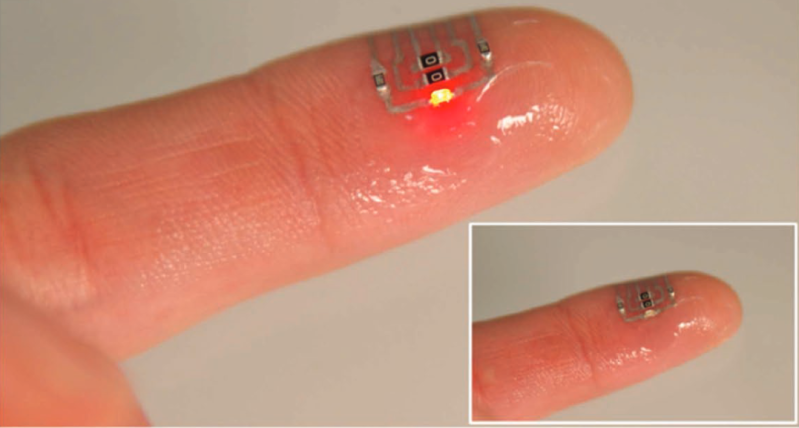Flexible circuit boards bend as you might expect from a playing card, while skin stretches more like knit fabric. The rules for making circuit boards and temporary tattoos therefore need to be different. Not just temporary tattoos, there are also circuits that reside on the skin so no unregulated heat traces, please. In addition to flexing and stretching, these tattoos can be applied to uneven surfaces and remain intact. Circuits could be added to the outside of projects or use the structure as the board to reduce weight and size. Both are possible with the research from Carnegie Mellon’s Soft Machines Lab and the Institute of Systems and Robotics at the University of Coimbra.
These circuits are an improvement over the existing method which relies on cropping away metal foil with a magnifying glass, tweezers and a steady hand. Instead, silver particles are printed with an inkjet printer before the traces are coated in eutectic gallium indium which is liquid metal at room temperature. If we were to oversimplify, we might describe it as similar to a non-toxic equivalent of mercury that we have also seen used in DIY OLEDs. This is a development likely to be interesting in a range of fields from medicine to cosplay.
Thank you, [Qes] for this tip via TechXplore.















Sticker.. its a sticker..
So not even as impressive as someone sticking components under their skin. Which mostly would qualify as “stupid” and “pointless” anyway. Glad we’ve got well-funded geniuses working on this. I wouldn’t want shit like this in my skin even if it were possible. I wouldn’t be keen even if it weren’t stupid and pointless.
The word tattoo is a bit misleading. But I’m sure that lot’s of parents will be relieved when their kid comes home with one of these tattoos and quickly find out that it’s just a gag.
But seriously, we all know that if they call it a thin sticker with conductive traces nobody will be interested in it. And to be honest, the less permanent character of a sticker over a tattoo is that it allows for updates, which are to be expected…
How does one make connections with the traces from above the skin? It seems like the process puts the decal film on top of the circuit.
Do we really know enough about gallium to say that contact with the skin is safe for extended periods of time?
I think the biggest challenge in the field of wearables is not how to make circuits but how to power them. A stciker battery would be a huge break theough even if didn’t have much stored energy (you could replace stickers daily).
Perhaps some kind of thermoelectric generator like https://news.ncsu.edu/2016/09/wearable-teg-heat-harvesting-2016/
I can barely even stand to wear a bandaide. When I have to I always feel it there and want it off me. I can’t imagine wearing this!